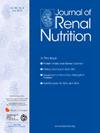Diet Quality Components and Gut Microbiota of Patients on Peritoneal Dialysis
IF 3.2
3区 医学
Q2 NUTRITION & DIETETICS
引用次数: 0
Abstract
Objectives
To evaluate the associations between the quality of the diet and its components and microbial diversity and composition in peritoneal dialysis (PD) patients.
Design and Methods
This cross-sectional study included PD patients for at least 3 months, aged 18-75 years and clinically stable. The Diet Quality Index (DQI), validated for the Brazilian population, is based on the energy density of 11 components (“sugar and sweets;” “beef, pork, and processed meat;” “refined grains and breads;” “animal fat;” “poultry, fish, and eggs;” “whole cereals, tubers, and roots;” “fruits”; “nonstarch vegetables;” “legumes and nuts;” “milk and dairy products;” and “vegetable oil”). A proportional score—based on the adequacy of the intake to Brazilian dietary guidelines—is calculated, and a final score ranged from 0 (worse) to 100 (better) is obtained. Fecal samples were collected at home, in a sterile material, kept refrigerated, and delivered to the clinic within 12 hours; α-diversity indices (Observed operational taxonomic units, Chao-1, Shannon’s, Gini-Simpson’s, Pielou eveness, and Faith phylogenetics) and microbial profile were determined by 16S ribosomal DNA with polymerase chain reaction-amplification and sequenced on an Illumina MiSeq platform.
Results
Forty-three participants were included (53.5% men, 52.4 ± 14.1 years, body mass index: 25.9 ± 4.1 kg/m2, 30.2% had diabetes mellitus). DQI score was 50.5 (41.9-54.9). The lowest energy density was for the components “animal fat” and “whole cereals and breads, tubers, and roots,” and the highest were for “refined grains and bread” and “beef, pork, and processed meat.” Diversity indices and Enterorhabdus genus were directly associated with the energy density of the components “whole cereals and breads, tubers, and roots” and inversely with “refined grains and bread,” after adjustments for age and diabetes.
Conclusions
Even low, the intake of whole cereals, tubers, and roots has the potential to positively influence the microbiota profile in PD patients.
腹膜透析患者饮食质量组成及肠道菌群。
目的:评价腹膜透析(PD)患者饮食质量及其成分与微生物多样性和组成之间的关系。设计和方法:本横断面研究纳入年龄18-75岁且临床稳定的PD患者,时间至少3个月。巴西人的饮食质量指数(DQI)基于11种成分的能量密度(“糖和甜食”;“牛肉、猪肉及加工肉类”;“精制谷物和面包”;“动物脂肪”;“家禽、鱼和蛋”;“全谷类、块茎和块根”;“水果”;“非淀粉蔬菜”;“豆类和坚果”;“牛奶及乳制品”;“植物油”)。根据巴西膳食指南的摄入量是否足够,计算出一个比例分数,并得到一个从0(较差)到100(较好)的最终分数。在家中收集粪便样本,用无菌材料保存,并在12小时内送到诊所。α-多样性指数(OTUs、chao1、Shannon’、gini - simpson’、Pielou均匀度和faith系统发育)和微生物谱采用16S核糖体DNA进行pcr扩增,并在Illumina MiSeq平台上测序。结果:纳入43例受试者(男性53.5%,52.4±14.1岁,BMI:25.9±4.1 kg/m2,糖尿病患者30.2%)。DQI评分为50.5(41.9 ~ 54.9)。能量密度最低的成分是“动物脂肪”和“全谷物和面包、块茎和根茎”,能量密度最高的成分是“精制谷物和面包”和“牛肉、猪肉和加工肉类”。在调整了年龄和糖尿病因素后,肠道菌属的多样性指数与“全谷物和面包、块茎和根”成分的能量密度呈正相关,与“精粮和面包”成分的能量密度呈负相关。结论:即使摄入量很低,全谷物、块茎和根类食物也可能对腹膜透析患者的微生物群有积极的影响。
本文章由计算机程序翻译,如有差异,请以英文原文为准。
求助全文
约1分钟内获得全文
求助全文
来源期刊

Journal of Renal Nutrition
医学-泌尿学与肾脏学
CiteScore
5.70
自引率
12.50%
发文量
146
审稿时长
6.7 weeks
期刊介绍:
The Journal of Renal Nutrition is devoted exclusively to renal nutrition science and renal dietetics. Its content is appropriate for nutritionists, physicians and researchers working in nephrology. Each issue contains a state-of-the-art review, original research, articles on the clinical management and education of patients, a current literature review, and nutritional analysis of food products that have clinical relevance.
 求助内容:
求助内容: 应助结果提醒方式:
应助结果提醒方式:


